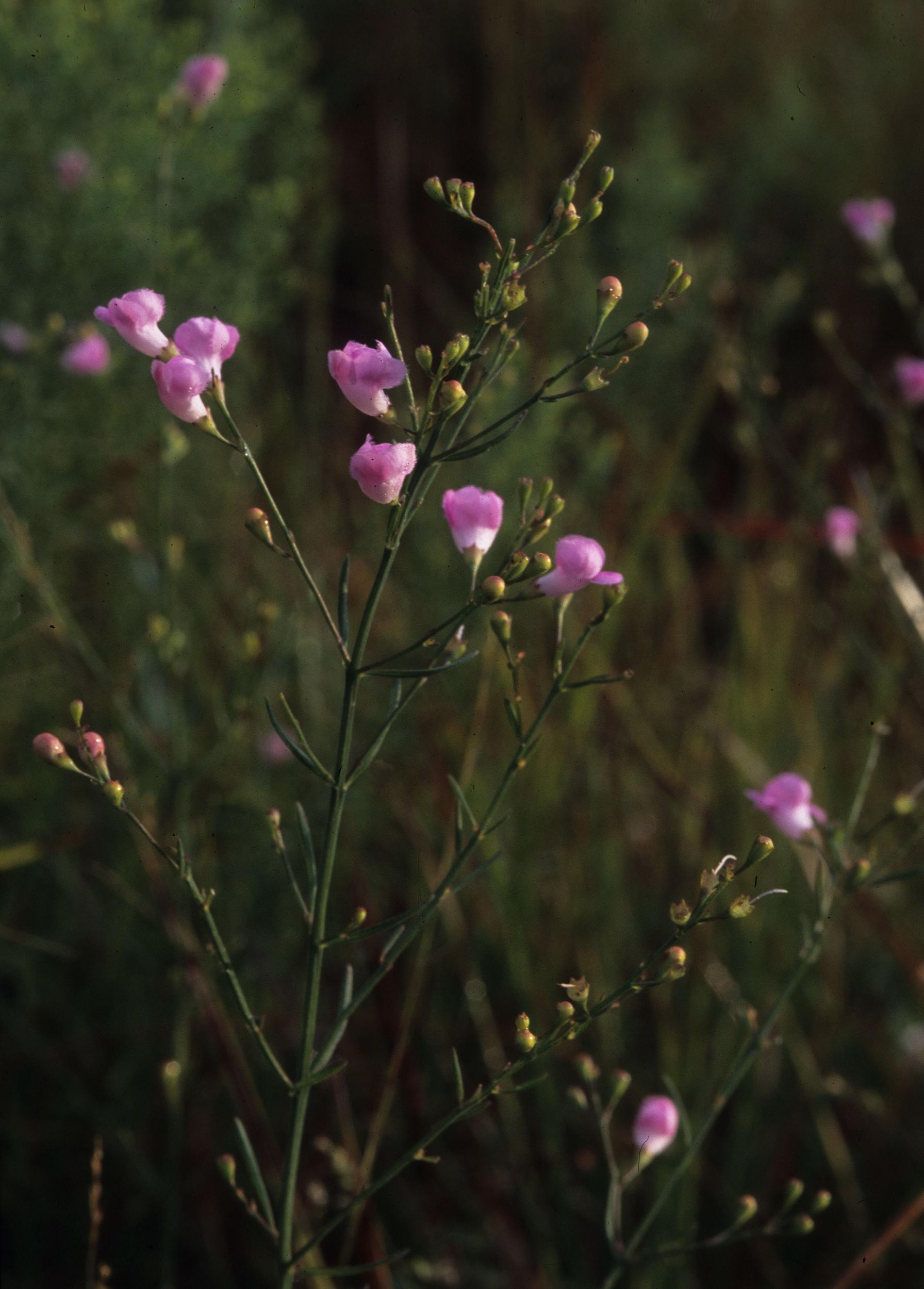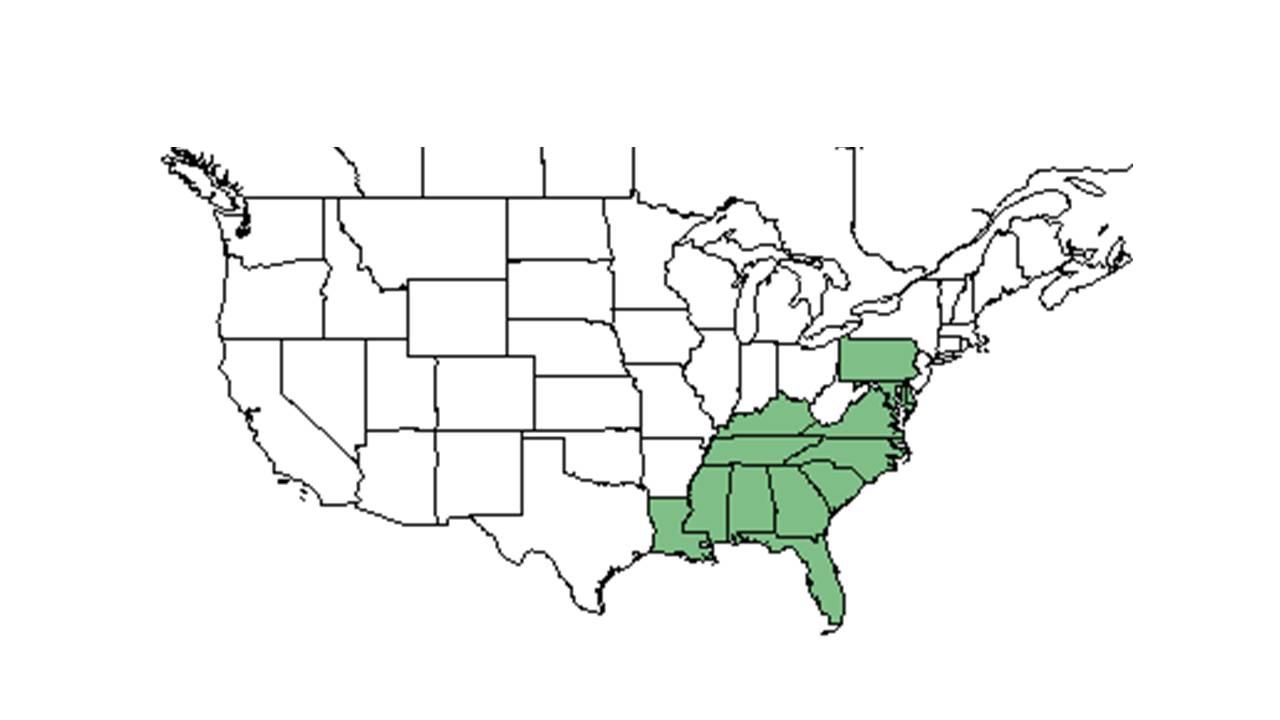Difference between revisions of "Agalinis obtusifolia"
| Line 33: | Line 33: | ||
==Ecology== | ==Ecology== | ||
===Habitat=== <!--Natural communities, human disturbed habitats, topography, hydrology, soils, light, fire regime requirements for removal of competition, etc.--> | ===Habitat=== <!--Natural communities, human disturbed habitats, topography, hydrology, soils, light, fire regime requirements for removal of competition, etc.--> | ||
| − | In the Coastal Plain it occurs in frequently burned upland pine communities (Ultisols), flatwoods (Spodosols), and wet meadows, savannas, and seepage slopes (pitcher plant bogs) including peaty areas (Histosols). | + | In the Coastal Plain it occurs in frequently burned upland pine communities (Ultisols), flatwoods (Spodosols), and wet meadows, savannas, and seepage slopes (pitcher plant bogs) including peaty areas (Histosols). A. obtusifolia also occurs on the margins of these communities.<ref name="wunderlin">Wunderlin, Richard P. and Bruce F. Hansen. Guide to the Vascular Plants of Florida. Second edition. 2003. University Press of Florida: Gainesville/Tallahassee/Tampa/Boca Raton/Pensacola/Orlando/Miami/Jacksonville/Ft. Myers. 547. Print.</ref> and seasonally on shallow calcareous soils of limestone glades in northern Florida and oolitic limerock of slash pine rocklands in sothern Florida.<ref name="FSU Herbarium">Florida State University Robert K. Godfrey Database. URL: [http://herbarium.bio.fsu.edu http://herbarium.bio.fsu.edu]. Last accessed: June 2014. Collectors: Loran C. Anderson, Wilson Baker, W. C. Brumbach, J.M. Canne, Robert K. Godfrey, J. Hays, Richard D. Houk, Ann F. Johnson, Nancy E. Jordan, R. Kral, R. Komarek, S.W. Leonard, Sidney McDaniel, and Alfred Schotz. States and Counties: Florida: Calhoun, Gadsden, Holmes, Jackson, Liberty, Monroe, Santa Rosa, Wakulla, and Walton. Georgia: Baker, Thomas, and Worth.</ref><ref name="Godfrey 1981"/> |
| + | |||
| + | It occurs in primarily high light areas maintained by fire or edaphic conditions but will tolerate the partial shade adjacent to open areas. It is tolerant of competition with dense grass and often occurs in conjunction in areas dominated by bunch grasses and sedges. It seems to be limited to native pine and wet prairie communities with minimal soil disturbance, although it can occur on roadsides.<ref name="FSU Herbarium"/> | ||
| + | |||
Associated species include ''Hypericum'', ''Eupatorium'', ''Seymaria'', ''Quercus'', and ''Liatris'' species, ''Agalinis divaricata''[http://coastalplainplants.org/wiki/index.php/Agalinis_divaricata], ''Agalinis filicaulis'', ''Aristida stricta''[http://coastalplainplants.org/wiki/index.php/Aristida_stricta], ''Pinus palustris''[http://coastalplainplants.org/wiki/index.php/Pinus_palustris], ''Aristida berichiana'', ''Serenoa repens''[http://coastalplainplants.org/wiki/index.php/Serenoa_repens], ''Schoenus nigricans'', ''Rhyncospora divergerns'', ''Schoenus nigricans'', ''Pinus elliottii''[http://coastalplainplants.org/wiki/index.php/Pinus_elliottii] and others.<ref name="FSU Herbarium"/> | Associated species include ''Hypericum'', ''Eupatorium'', ''Seymaria'', ''Quercus'', and ''Liatris'' species, ''Agalinis divaricata''[http://coastalplainplants.org/wiki/index.php/Agalinis_divaricata], ''Agalinis filicaulis'', ''Aristida stricta''[http://coastalplainplants.org/wiki/index.php/Aristida_stricta], ''Pinus palustris''[http://coastalplainplants.org/wiki/index.php/Pinus_palustris], ''Aristida berichiana'', ''Serenoa repens''[http://coastalplainplants.org/wiki/index.php/Serenoa_repens], ''Schoenus nigricans'', ''Rhyncospora divergerns'', ''Schoenus nigricans'', ''Pinus elliottii''[http://coastalplainplants.org/wiki/index.php/Pinus_elliottii] and others.<ref name="FSU Herbarium"/> | ||
Revision as of 12:57, 21 June 2021
| Agalinis obtusifolia | |
|---|---|

| |
| Photo was taken by Gil Nelson | |
| Scientific classification | |
| Kingdom: | Plantae |
| Division: | Magnoliophyta - Flowering plants |
| Class: | Magnoliopsida - Dicotyledons |
| Order: | Lamiales |
| Family: | Orobanchaceae |
| Genus: | Agalinis |
| Species: | A. obtusifolia |
| Binomial name | |
| Agalinis obtusifolia Raf. | |

| |
| Natural range of Agalinis obtusifolia from USDA NRCS Plants Database. | |
Common name: Tenlobe false foxglove
Contents
Taxonomic notes
Synonyms: A. decemloba (Greene) Pennell; A. tenella Pennell; Gerardia obstusifolia (Rafinesque) Pennell.[1]
Description
Agalinis obtusifolia is a light yellow-green colored annual plant that is parasitic to the roots of grasses and other herbs. The stems are slender, stiff, and branched from the upper half. They grow between 30 – 90 cm tall and have narrow, short leaves that are rough to the touch. The flowers are distinct terminal clusters that are rose-lavender or (rarely) white in color with 4 stamens and elongated stigmas. [2]
Distribution
A. obtusifolia is infrequent in all of Florida. Found west to Mississippi and north to Pennsylvania.[3] It's found within the Coastal Plain, from Delaware to the Florida Keys, westward to southeastern Louisiana,[4] with disjunct populations in the Eastern Highland Rim and Cumberland Plateau regions of Tennessee and Kentucky.[5]
Ecology
Habitat
In the Coastal Plain it occurs in frequently burned upland pine communities (Ultisols), flatwoods (Spodosols), and wet meadows, savannas, and seepage slopes (pitcher plant bogs) including peaty areas (Histosols). A. obtusifolia also occurs on the margins of these communities.[6] and seasonally on shallow calcareous soils of limestone glades in northern Florida and oolitic limerock of slash pine rocklands in sothern Florida.[7][4]
It occurs in primarily high light areas maintained by fire or edaphic conditions but will tolerate the partial shade adjacent to open areas. It is tolerant of competition with dense grass and often occurs in conjunction in areas dominated by bunch grasses and sedges. It seems to be limited to native pine and wet prairie communities with minimal soil disturbance, although it can occur on roadsides.[7]
Associated species include Hypericum, Eupatorium, Seymaria, Quercus, and Liatris species, Agalinis divaricata[1], Agalinis filicaulis, Aristida stricta[2], Pinus palustris[3], Aristida berichiana, Serenoa repens[4], Schoenus nigricans, Rhyncospora divergerns, Schoenus nigricans, Pinus elliottii[5] and others.[7]
Phenology
Agalinis obtusifolia has been observed to flower March through November,[7] with peak inflorescence in September and October in northern Florida.[8] This species also starts to fruit September through October.[7]
Seed dispersal
This species is thought to be dispersed by gravity. [9]
Seed bank and germination
Length of seed viability within the seed bank is unknown.[10]
Fire ecology
It does well in frequently burned old growth longleaf pine and wiregrass savannas.[7]
Pollination
Pollination occurs by selfing and out-crossing. Specific pollinators have not been documented.[10]
Use by animals
Agalinis species, including this one, host larvae of the common buckeye butterfly (Junonia coenia) in Florida.[11]
Conservation, cultivation, and restoration
A. obtusifolia is listed as endangered in the states of Kentucky and Maryland, and is listed as extirpated in the state of Pennsylvania. [12]
Cultural use
Photo Gallery
References and notes
- ↑ Weakley, A.S. 2015. Flora of the southern and mid-atlantic states. Working Draft of 21 May 2015. University of North Carolina at Chapel Hill, Chapel Hill, North Carolina.
- ↑ Radford, Albert E., Harry E. Ahles, and C. Ritchie Bell. Manual of the Vascular Flora of the Carolinas. 1964, 1968. The University of North Carolina Press. 960. Print.
- ↑ Hall, David W. Illustrated Plants of Florida and the Coastal Plain: based on the collections of Leland and Lucy Baltzell. 1993. A Maupin House Book. Gainesville. 342. Print.
- ↑ 4.0 4.1 Godfrey, Robert K. and Jean W. Wooten. Aquatic and Wetland Plants of Southeastern United States: Dicotyledons. 1981. University of Georgia Press. 663, 665. Print.
- ↑ Sorrie, B. A. and A. S. Weakley 2001. Coastal Plain valcular plant endemics: Phytogeographic patterns. Castanea 66: 50-82.
- ↑ Wunderlin, Richard P. and Bruce F. Hansen. Guide to the Vascular Plants of Florida. Second edition. 2003. University Press of Florida: Gainesville/Tallahassee/Tampa/Boca Raton/Pensacola/Orlando/Miami/Jacksonville/Ft. Myers. 547. Print.
- ↑ 7.0 7.1 7.2 7.3 7.4 7.5 Florida State University Robert K. Godfrey Database. URL: http://herbarium.bio.fsu.edu. Last accessed: June 2014. Collectors: Loran C. Anderson, Wilson Baker, W. C. Brumbach, J.M. Canne, Robert K. Godfrey, J. Hays, Richard D. Houk, Ann F. Johnson, Nancy E. Jordan, R. Kral, R. Komarek, S.W. Leonard, Sidney McDaniel, and Alfred Schotz. States and Counties: Florida: Calhoun, Gadsden, Holmes, Jackson, Liberty, Monroe, Santa Rosa, Wakulla, and Walton. Georgia: Baker, Thomas, and Worth.
- ↑ PanFlora: Plant data for the eastern United States with emphasis on the Southeastern Coastal Plains, Florida, and the Florida Panhandle. www.gilnelson.com/PanFlora/ Accessed: 15 JAN 2016
- ↑ Kirkman, L. Katherine. Unpublished database of seed dispersal mode of plants found in Coastal Plain longleaf pine-grasslands of the Jones Ecological Research Center, Georgia.
- ↑ 10.0 10.1 [[6]]NatureServe. Accessed: March 22, 2016
- ↑ Observation by Roger Hammer in Silver Springs State Park, Marion County, FL. September 2016, posted to Florida Flora and Ecosystematics Facebook Group August 4, 2017.
- ↑ USDA Plants Database URL: https://plants.usda.gov/core/profile?symbol=ANGE